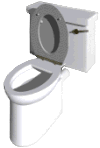Project Aura: Are You Sitting Comfortably?
Created | Updated Oct 30, 2011

This disturbing piece of research was found in Peer Review. It appears here by popular demand, as befitting the season that's in it.

In the 1990s, a bizarre Japanese research program was adapted and exploited by various Western governments. Their objective was the development of an enhanced surveillance capability, but the outcome was a profoundly intrusive technology that might still be in use today. Those who know where and to what degree aren’t telling, however. No politician or law enforcement authority will freely admit to involvement in Project Aura. The reasons for this secrecy are easy to appreciate once the facts are known.
The information contained in this Entry was divulged by an acquaintance who claims to have been informed about the project by American agents while he was working for the Israeli secret service. Its veracity cannot be confirmed, but every question asked elicited a straightforward and plausible answer.
The Human Electromagnetic Field
The fact that human beings emit electromagnetic fields has been known for decades. The German physician Mesmer performed investigations of the phenomenon in the late 18th Century, even before any coherent scientific description of electromagnetic radiation had been proposed. Contemporaries of Faraday detected both the pulsing of the heart and electrical activity in the brain stem more than 150 years ago, and the extensions of these techniques have given us the electrocardiogram (ECG) and electroencephalogram (EEG) of modern medicine.
During the 20th Century, several experts1 speculated that the Human Electromagnetic Field (HEF) appeared to be individually characteristic and so might be used to identify a person in the same way that a fingerprint can be. The HEF is rather weak, however, and its detectable manifestation is strongly affected by many factors, including atmospheric conditions, skin moisture and perhaps most important the influence of clothing. Our clothes not only attenuate our bodies’ fields, but may also generate their own.
Experiments using subcutaneous (and hence invasive) electrodes and transmitters nonetheless proved that the electrical activity in the human body is indeed individually characteristic, though it varies greatly with levels of physical activity and tends to alter cyclically over time. By the 1980s, however, Japanese researchers had discovered that the frequency spectrum of the HEF, analysed over its full range, exhibits particular characteristics that do not change, and that these characteristics could therefore serve to uniquely identify an individual.
The Detector Concept
If this discovery was to yield a surveillance technique, the challenge would be one of performing a sweep of this spectrum without the subject realising it. This meant that the penetrating electrodes used thus far had to be replaced by external coils. A fast scan required a high energy input, resulting in a detectable sensation. The researchers found that several seconds were needed to complete a sweep at a subliminal level, and even then the detector needed to be very close to bare flesh which remained motionless throughout the measurement period.
Public telephone handsets seemed to offer promise as means to achieve this, except that technological trends were already foretelling their obsolescence, and in any case the way in which people held them was not consistent. The Japanese found only one way to make the measurement reliably. The right conditions prevailed when the subject sat on a toilet, with the field coils concealed in the seat. Attempts to reproduce the measurement in a less contentious setting, for example by using handrails on escalators, were unsuccessful. The idea of keeping track of members of the public through their use of lavatories proved too much even for Japanese sensibilities, and the research was dropped.
Covert Development
The continuation of the technology now became even more inconspicuous. It is thought that the Central Intelligence Agency learned of the concept from Japanese academics. A replication of the research seems to have been undertaken, though whether this was in the United States or merely under US administrative control is unclear.
Whereas the original Japanese research is said to have engaged informed subjects, the new research soon became entirely covert. Lavatories used by the public were adapted, and the majority of experimental subjects therefore had no idea that they were being monitored during the most private of their personal activities. It is even possible that these adaptations included the collection of samples of excreted material in some cases. The HEF characterisation would have needed to be validated using some independent benchmark in order to demonstrate the accuracy and reliability of the method. Provided that biological specimens could be procured, the evolving technology of genetic fingerprinting would have been ideal for this purpose.
Statistical analysis was also undertaken to determine how many installations would be needed to perform an effective surveillance activity. Although the resulting projections are not known, they seem (at least at first) to have been considered viable. The developed technology was cheap and unobtrusive. Field coils, sensors and signal conditioners, a sealed-for-life battery pack and a remotely-activated telemetric transmitter could all be encapsulated in a solid toilet seat for less than a hundred dollars. Funding for a global roll-out was apparently secured, and a search for international partners began.
Fading Aura?
It was at this time in the late 1990s that most of the information about Project Aura was learned. The number of working installations by this time was claimed to be in the tens of thousands, with examples on six continents and in dozens of different countries.
Project Aura subsequently began to reveal its limitations, however. Installing and maintaining the detectors could be most easily accomplished in societies where large state-controlled institutions (such as local government offices, hospitals, educational establishments and state-engaged corporations) interact with the public. Unfortunately, the focus of counter-terrorism shifted after 9/11 to places which possess little of this infrastructure. The cultures under scrutiny were also increasingly male-dominated ones, which was unhelpful since (for obvious reasons) the Aura concept is more suited to tracking women than men. Research was commissioned into the excretory practices of different societies, and the Department for Homeland Security was dismayed to learn that not all of them are in the habit of sitting down to perform their ablutions2.
The enthusiasm for Project Aura has surely declined, and the project’s status today is unclear. If a large number of installations were indeed completed world-wide, however, there is no obvious reason why they should have been decommissioned. Doing so would have cost a lot of money, and drawing attention to the project might of course have worse consequences for democratically-elected governments than the expedient of quietly forgetting about it.

If the devices are still in place, moreover, then their use will remain an option. The portable receiver units, capable of recording and characterising a ‘fannyprint’3 will still be quite serviceable. They will be operable from the cubicle next door and indeed from much longer range than that. The batteries in the seats will keep working for a few years yet.
Is Aura real technology or an urban myth? Short of cutting large numbers of toilet seats to pieces, it’s impossible for the general public to tell. But the parting shot of the acquaintance who revealed the story is pertinent: none of this will make any of us sit easier, the next time we use a public toilet.
